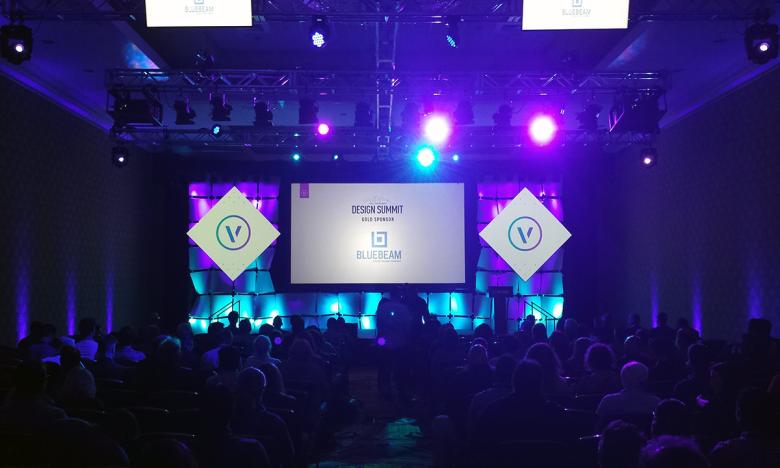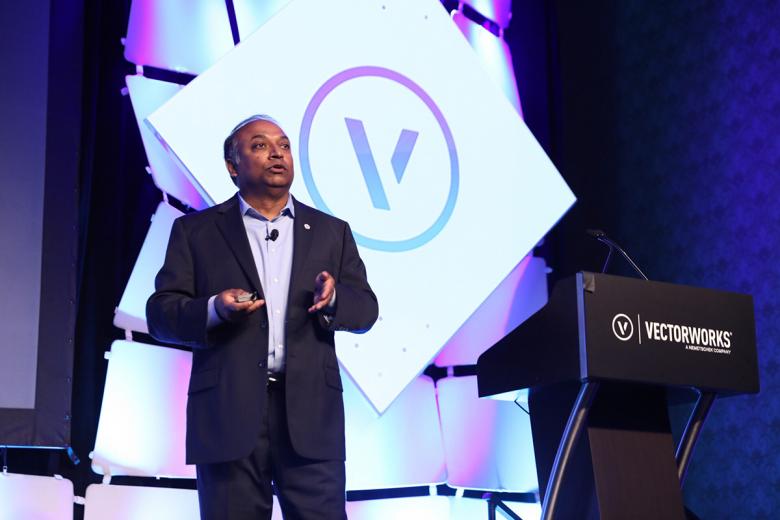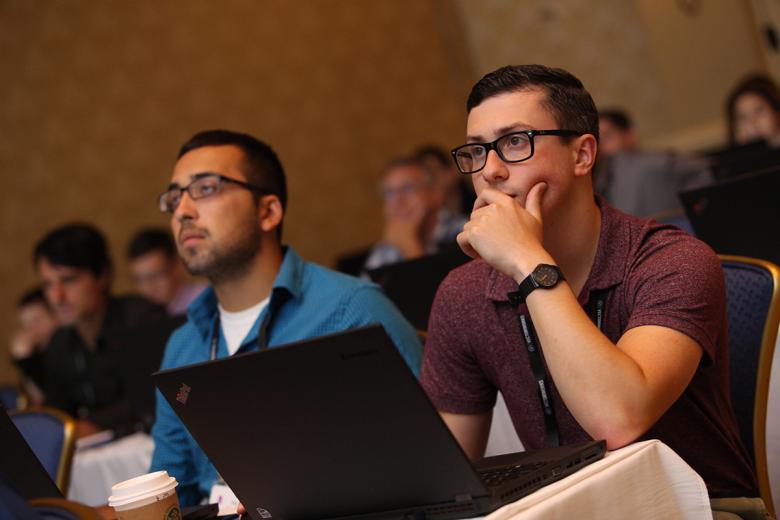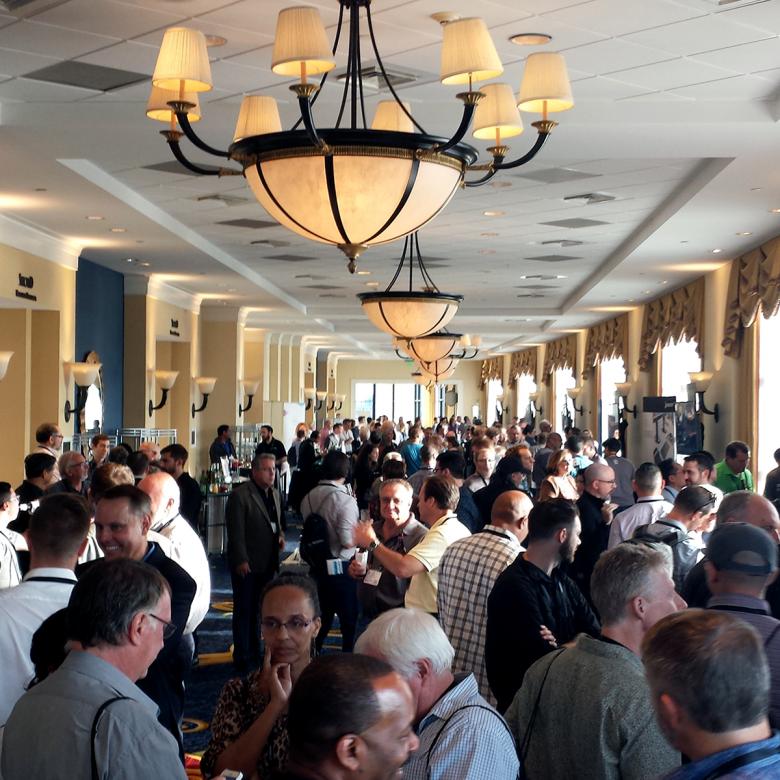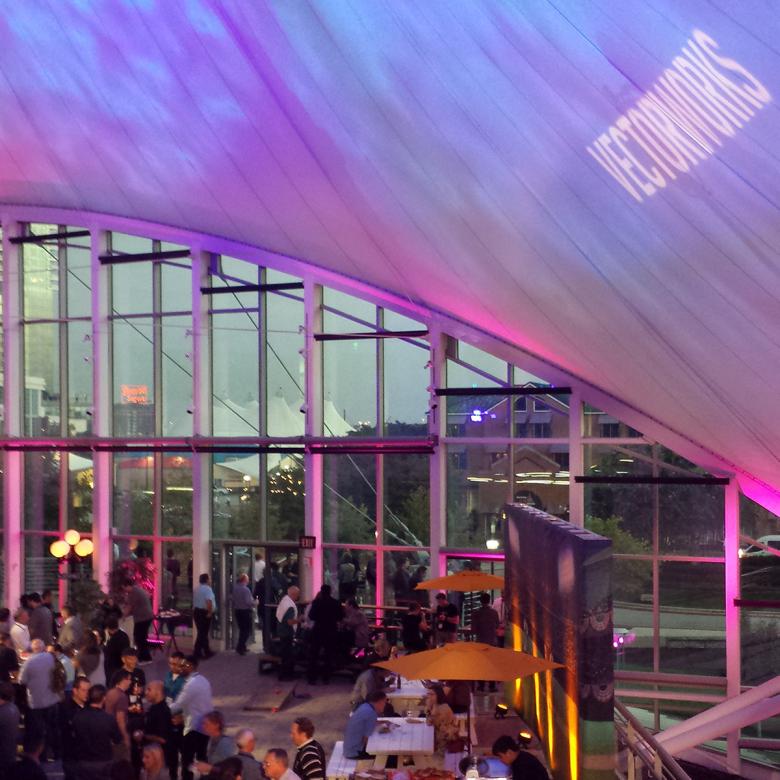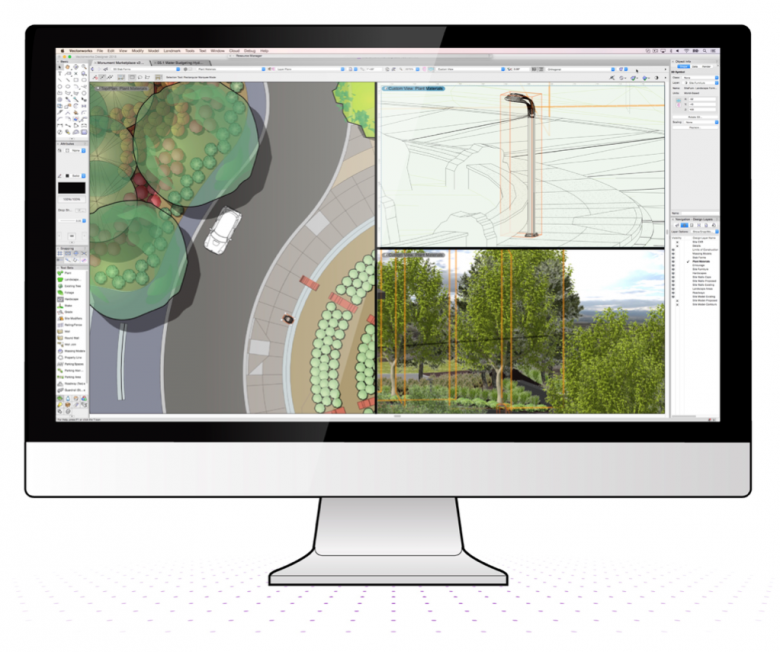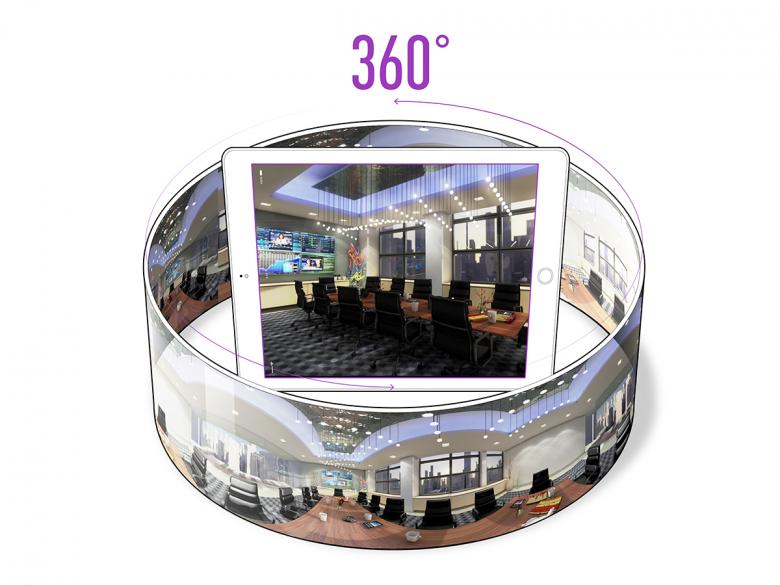Vectorworks Design Summit 2017
John Hill
9. octubre 2017
The set and lighting for the Summit's keynotes were a dramatic display of what's possible with Vectorworks software. (Photo: John Hill/World-Architects)
The Vectorworks Design Summit 2017 took place over three days last month in Baltimore, not far from the software company's U.S. headquarters in Columbia, Maryland. Just like last year's event in Chicago, World-Architects served as an Exclusive Media Partner. Here is our recap of the Summit's three days of keynotes, learning, and networking.
This year's Vectorworks Design Summit was the third annual event open to users of Vectorworks' line of software for architects, landscape architects, and designers in the entertainment industry. The Summits, which started in Philadelphia in 2015, provide training sessions and presentations geared around the software. They also give architects and other users unfettered access to the developers of the programs they use everyday. This access is one of the most unique aspects of the Vectorworks Design Summit, which saw nearly 500 attendees this year.
Spread across the fourth floor of the Baltimore Marriott Waterfront Hotel, the three-day Summit (18-20 September) consisted of an Expo, with tables highlighting some of the new features in Vectorworks 2018; two keynotes; numerous presentations and training sessions, most eligible for continuing education credits; and a Customer Appreciation Dinner at the nearby Columbus Center. Rather than a day-by-day recap, here we present a few main strands of the Summit – keynotes, sessions, networking – followed by some highlights from the new release of Vectorworks software.
Keynotes
Vectorworks CEO Dr. Biplab Sarkar during the opening keynote (Photo courtesy of Vectorworks)
Like last year, when he had just taken the reigns of Vectorworks, CEO Dr. Biplab Sarkar gave the opening keynote. In lieu of the developers behind the scenes, this time he was joined by four users who shared their experiences in using Vectorworks software on architecture, landscape, and entertainment projects. Before that he gave a background on the company and its software development over the couple decades, stating at one point that 70% of the new features in Vectorworks 2018 came from such users as those assembled in the ballroom. Users I spoke with during the Summit's three days echoed this sentiment – often incredulously, both at the receptiveness of the developers and the speed at which they have been able to incorporate new features.
After his initial remarks, Sarkar was followed by Marc Pancera, head of BIM at Switzerland's Itten+Brechbühl. The large architecture and planning company has used Vectorworks on a number of its projects, but none as large as a 21-building, joint-venture project currently underway in Ticino. Pancera described how they are taking advantage of the software's IFC-based, open-BIM features for collaborating with its partner and other consultants across different software platforms. Next came Paul Beaty-Pownall, managing director of BPR Architects in London, who spoke about the firm's transportation, educational, and other projects that were designed in Vectorworks. He also recounted the "BIM + Beers" sessions that he enacted in the firm's efforts to shift from 2D to 3D and streamline their work in Vectorworks. Following these architects were Adam Greenspan, partner at PWP Landscape Architecture, and Remco Teunissen, owner at RTN Showsupport, who spoke respectively about the use of Vectorworks in landscape and entertainment projects.
While the new features in Vectorworks 2018 focus on user workflows and therefore don't generate as many "woo-hoos" as, for instance, last year's web view/VR, Sarkar wrapped up the keynote with some flashier pieces that his developers are working on for future updates. These include 3D photo modeling that enables users to generate a mesh in Vectorworks from a series of stitched photos; AR (augmented reality) software that will work without the need for additional hardware; and machine learning for auto coloring renderings and styling them in a variety of drawing styles, some based on famous paintings.
Allied Works Architecture founder Brad Cloepfil during the closing keynote (Photo courtesy of Vectorworks)
The closing keynote was given by Brad Cloepfil, the founding principal of Allied Works Architecture, which has offices in Portland, Oregon, and New York. Keynotes like this aim to inspire, and Cloepfil delivered by talking about his process of developing ideas, his reliance upon hand drawing and, fittingly for the Summit, his firm's use of Vectorworks for nearly twenty years. He ran through some of the firm's impressive completed buildings – a guest house in Dutchess County, New York, the Clyfford Still Museum in Denver, and the recently completed National Music Centre of Canada – and then concluded the talk with a couple exciting projects now under construction: the U.S. Embassy in Mozambique and the National Veterans Memorial & Museum in Ohio.
Between projects he inserted slides with statements about Vectorworks – e.g. "Vectorworks ... best translates the physical act and creative value of drawing into the digital realm" – but none was more memorable than these words: "We are omnivores. We use every tool and technique we can find to produce the best work." So Vectorworks is one among a number of digital tools (including Rhino and Grasshopper) that Allied Works uses toward realizing the firm's high-quality output. Cloepfil also said, during a brief Q&A at the end of his talk, that Allied Works could probably do more in Vectorworks than it currently does, particularly in the realm of BIM. At the same time he acknowledged that finding young architects trained in Vectorworks rather than Revit is difficult, but it's something he hopes to continue as long as possible given his positive experiences with the software.
Sessions
Photo courtesy of Vectorworks
The bulk of this year's Vectorworks Design Summit was made up of sessions that broadly fall into one of two types: training and presentations. Each of the training sessions lasted a few hours and gave users hands-on experience in some aspect of Vectorworks. A few of the architect-related training sessions included the two-part "Basics of BIM," "Rendering: Fake It 'Til You Make It," and "The Art and Function of 3D Modeling." I sat in on the last and observed Luis M. Ruiz, a senior architect product specialist at Vectorworks, acclimate users to navigating the 3D environment and then school them in the different functions for modeling. Anchoring the class in a real-world example, Ruiz demonstrated three ways of modeling the shells of Richard Meier's Jubilee Church in Rome: via a hemisphere, by extruding and bending, and by extruding along a path.
Photo courtesy of Vectorworks
The shorter sessions were made up of presentations given by users and therefore grounded in real-world situations. Daniel Irvine and Jean Dières Monplaisir of Vancouver's Principle Architecture presented a case-study, an unbuilt design for an exhibition on the history of wood. Their immersive, free-form installation in timber was designed in Vectorworks through the use of its native Marionette parametric scripting. Suited to the project's short time frame and unknown contents, the parametric design was easily adjusted as the project's contents became known and other parameters changed. UK architect Jonathan Reeves, on the other hand, recounted stories from his eponymous practice as well as the architects he has worked with as a Vectorworks trainer, some of them found in his 2015 book, Innovative Vectorworks BIM. Using a few examples from his own practice – including an award-winning, 48-hour collaborative design charrette for a tower in New York's Hudson Yards – Reeves strove to give participants ideas on how to make the most of BIM in their own projects.
Drinks and Dinner
Social hour with drinks and Vectorworks stations on opening night (Photo: John Hill/World-Architects)
No conference is complete without networking. The Vectorworks Design Summit was no different, made up primarily of two evening gatherings. Drinks were dispensed on the first night on the Expo floor, where Vectorworks had set up tables about some of the new features in Vectorworks 2018. It functioned as a laid-back way of allowing users to learn about the new features and ask questions to the developers behind the technology.
Customer Appreciation Dinner at the Columbus Center, designed by Zeidler Roberts Partnership (Photo: John Hill/World-Architects)
The second night was capped by the Customer Appreciation Dinner, held at the Columbus Center not far from the Marriott. Just as the sets and lighting for the keynotes acted as an expression of the Vectorworks entertainment software, the fabric roof designed by Zeidler Roberts Partnership was a fitting canvas for a Vectorworks light show. It was also a great setting for tasty food stations catered by Hill Culinary.
Vectorworks 2018
Multiple Drawing Views (Image courtesy of Vectorworks)
Vectorworks 2018 was released one week before the Vectorworks Design Summit. Therefore the event served to familiarize users with new features in its line of software: Designer, Architect, Landmark, Spotlight, and Fundamentals, as well as Vision. Speaking with some users over the Summit's three days, it seemed almost unanimous that architects were most excited about the Multiple Drawing Views feature, which enables users to view their project simultanously in different views and gives them the ability to begin work in one pane and finish it in another. Like this command, other new features for Architect are geared to user workflow, such as Direct Section and Elevation Editing, which allows users to edit these drawings directly in viewports; Streamlined Drawing Distribution and Worksheets, and Improved Revit Import. Outside of Architect, the value of Braceworks, a new structural analysis feature targeted to designers and riggers working on temporary entertainment structures, was put on display during the Summit: it was used to determine the trusses for lighting the keynotes.
360 rendered panorama (Image courtesy of Vectorworks)
Although there isn't an equivalent to last year's applause-generating web view/VR feature, Vectorworks 2018 does include New Rendered Panoramas, in which architects can send their clients 360-degree intractive views of digital models via Renderworks. With this in mind, we're looking forward to next year's Summit and software update when 3D photo modeling, AR, machine learning, and other features should grab the spotlight.
World-Architects is an Exclusive Media Partner for the third annual Vectorworks Design Summit, which took place in Baltimore 18-20 September 2017.
Artículos relacionados
-
BIM, Beers and BPR
4/12/17
-
Designing with Marionette
6/11/17
-
How Allied Works Works
23/10/17
-
Vectorworks Design Summit 2017
9/10/17
-
Vectorworks 2018 Released
13/9/17
